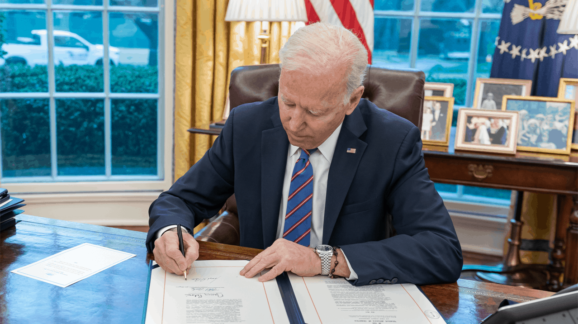The Threat from Biden’s ‘Whole of Government’ Regulatory Approach
Government coercion is not the source or protector of the humanitarian values progressives claim to champion.
When the U.S. federal administrative state began its march from novelty to leviathan over a century ago, few likely imagined the tangle of rules it would produce and how those would envelop society. Rules and programs have accumulated, decade after decade, with little retrenchment.
During former president Trump’s four years, there were some unique reversals, with an unprecedented attempt to make federal agencies streamline unneeded regulations and take steps like accelerating permitting for large-scale, private energy-infrastructure projects. The Biden administration immediately reversed even modest liberalizations such as Trump’s “one-in/two-out” directive along with a requirement that agencies publish their multitudes of sub-regulatory guidance documents online.
Since President Biden’s inauguration in January 2021, there’s been a radical shift in Washington’s regulatory agencies. As I document in my annual “Ten Thousand Commandments” report detailing Washington’s “hidden tax” burden, Biden scrapped modest reforms by Trump and replaced that with “whole-of-government” progressive goals in “competition policy” and antitrust, climate policy, Environmental Social Governance (ESG) and “equity,” digital currency, and other issues.
In a directive announcing the first of many Trump policy reversals and new impositions of his own, Biden declared the Trump regulatory architecture to consist of “harmful policies and directives that threaten to frustrate the Federal Government’s ability to confront . . . problems.” Even before assuming office, Biden’s team singled out dozens of specific Trump rulemakings for review and reversal, with an eye toward explicitly rolling back the entirety of the streamlining Trump had attempted. (Granted, plenty Trump did was not deregulatory.)
Biden’s progressive reimagining of the regulatory state is rooted in his “Modernizing Regulatory Review” directive to departmental and agency heads to “modernize and improve the regulatory review process” and to ensure it “fully accounts for regulatory benefits that are difficult or impossible to quantify, and does not have harmful anti-regulatory or deregulatory effects.” The problem is that the White House Office of Management and Budget (OMB) — the body charged with regulatory supervision, restraint, and purported assurance that cost-benefit analysis actually happens — has been transformed into a regulatory promoter, amplifier, and initiator of central government action. Regulatory oversight (modest as it was) was replaced with a mandate to “promote public health and safety, economic growth, social welfare, racial justice, environmental stewardship, human dignity, equity, and the interests of future generations” — as progressives see them.
Even the ostensibly independent Federal Reserve, for example, rather than sticking to monetary stability, has shifted to emphasize climate change, undertaking a “climate scenario analysis” in bank stress tests to steer capital away from fossil-fuel energy. Likewise, the Employee Benefits Security Administration wants fund managers to consider climate change and other ESG factors — not just financial returns that benefit people — in assessing investment risks and returns.
Another problem is that Biden is using the unequaled spending, hiring, contracting, and procurement heft of the federal government — the largest purchaser of goods and services on earth, and the largest employer in the U.S. — to pressure the private sector to go along with progressive policies.
Looking ahead is not encouraging, either. Recent statutory enactments by Congress, including the CARES Act, the American Rescue Plan, and the so-called “Infrastructure,” “Innovation” and “Inflation” Acts, will add to debt spending and regulatory mandates. Altogether, this means a greater cost of doing business and a proliferation of subsidized or federally steered jobs in white-elephant projects such as a national EV-charging infrastructure.
Read the full article at National Review.
